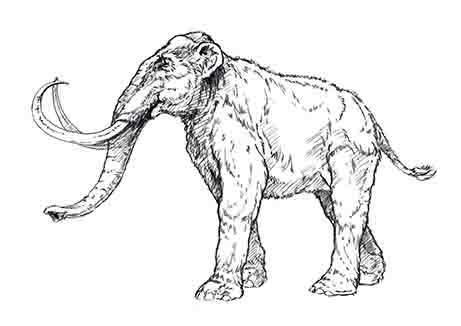
When Elephants Roamed Maryland
Richard D. L. Fulton
One would hardly expect to see a wild elephant wandering about the landscape in Maryland today unless it was a zoo or circus escapee, but there was a time when the sight of them would not have seemed to be so out of the ordinary.
In fact, there was a time when Maryland served as the home to three different types of elephants.
The state’s indigenous elephants plodded the Maryland landscape from 12 million years ago until about 10,000 years ago, some having likely been hunted by prehistoric humans, who followed animal migration trails that led through Maryland.
The oldest elephant among the state’s prehistoric ones was the Gomphotherium, meaning “welded beast” in Latin, so named in reference to its tusks. The species of Gomphotherium, whose remains have been found in Maryland, is Gomphotherium calvertensis, named for the Calvert Cliffs on the Chesapeake Bay, the area in which a number of teeth were discovered.
Gomphotherium calvertensis was initially described and named in 1950. The animal lived during a period of time designated as the Miocene Epoch, which lasted from about 18 to 5 million years ago, when much of Eastern Maryland was submerged under the Atlantic Ocean. It’s been estimated that Maryland’s Gomphotherium lived about 12 million years ago, according to Stephen J. Godfrey, Calvert Marine Museum (CMM)’s curator of paleontology.
Gomphotherium lived when the shoreline of the Atlantic Ocean extended westward beyond Washington, D.C. The CMM has a number of this elephant’s teeth, as they were buried in marine sediments, having been washed there via rivers that emptied into the sea.
Godfrey wrote in Maryland’s Prehistoric Elephants (CMM’s Bugeye Times, Winter 2009-2010) that Gomphotherium stood some ten feet tall at the shoulders and weighed in at around four to six tons.
The unusual feature of this creature was that it possessed four straight tusks, a pair of upper tusks and a pair of lower tusks. In spite of the unusual array of tusks, it is held that modern elephant of today descended from Gomphotherium stock.
The Miocene Epoch was superseded by the Pliocene Epoch, which lasted from five to two million years ago, and during which period the gomphotheres eventually became supplanted by more modern types, one of which was the American mastodon (specifically Mammut americanum). The name Mammut means “earth burrower,” referring to the one-time belief that their remains that had been found in Russian fields were left by burrowing animals.
The presence of mastodons in Maryland was established by the finding of two isolated teeth, one of which was dredged from the Chesapeake Bay near the nuclear power plant, while the second was found in a stream located in Anne Arundel County, according to Godfrey.
Adult mastodons averaged ten-feet tall at their shoulders and weighed an estimated five tons.
The mastodons in Maryland were also joined by the appearance of another elephant during the Pliocene, the far-more renowned hairy and aptly named Woolly Mammoth (the animated hero of the movie, Ice Age). With regard to the prehistoric elephants, mammoths are the most closely related to the present-day elephants.
Godfrey noted these behemoths stood up to 12 feet in height at the shoulders and could have very well weighed eight tons.
The period of time following the Pliocene was called the Pleistocene (Ice Age) Epoch, which lasted from two million years ago to 11,700 years ago, and both the mastodon and mammoth shared their territories during the entire epoch, as well as into the subsequent period of time known as the Holocene Epoch (which began about 11,700 years ago with the commencement of the period of global warming the Earth has been continuously experiencing since, to date).
One of the highly interesting aspects of the Ice Age in Maryland, is that, while there were no glaciers in Maryland, so much water was tied-up in continental ice that Maryland’s land mass extended to the east for some 300 miles, meaning that much of the land in Maryland that served as home to the mastodons, mammoths, and prehistoric humans is today under the sea.
The mastodons and mammoths were both hunted by early man, which likely also took place in Maryland given that the elephants and prehistoric humans coexisted in the state. Both elephants, however, eventually became extinct around 10,000 years ago.
*Cover Photo: Public Domain Mammoth, Courtesy of Needpix.com
Gomphotherium

Gomphotherium Illustration by Tim Scheirer, Courtesy of CMM

Gomphotherium Tooth: Photo by S. Godfrey, Courtesy of CMM
Mastodon

Mastodon Illustration by Tim Scheirer, Courtesy of CMM

Mastodon Tooth: Photo by S. Godfrey, Courtesy of CMM

Mammoth
Mammoth Illustration by Tim Scheirer, Courtesy of CMM

Mammoth Jaw: Photo Courtesy of the Smithsonian Institution National Museum of Natural History
